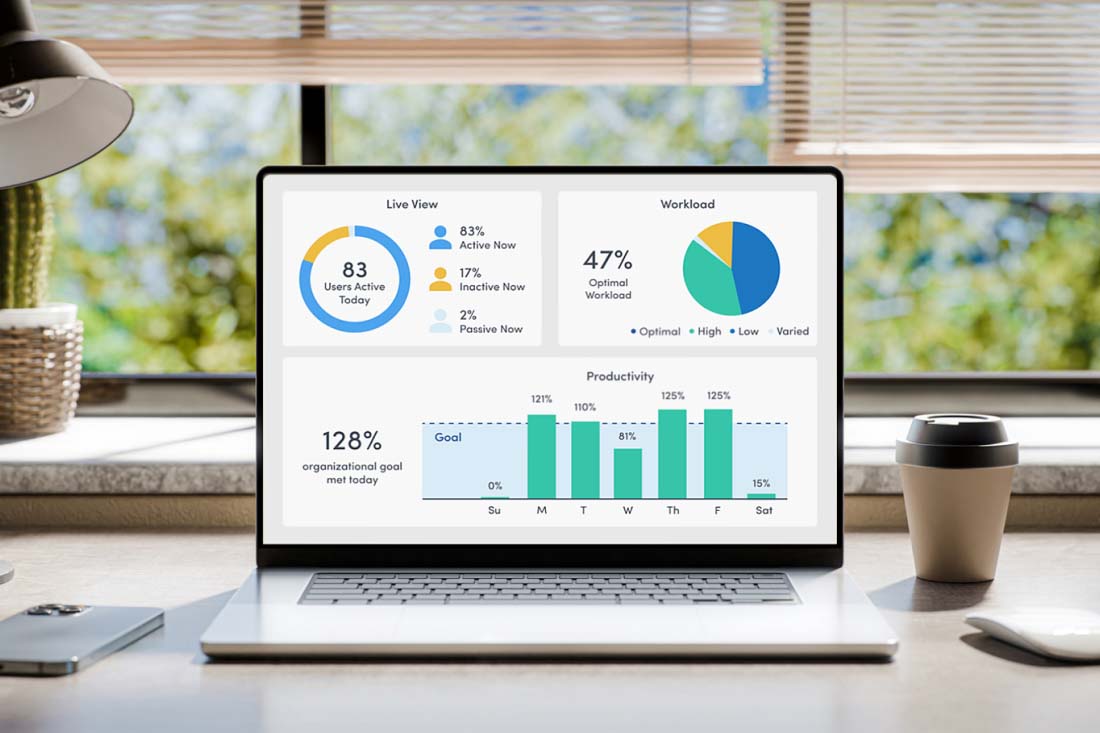We’ve all experienced the power of data to drive performance and fuel growth. Starbucks uses it to select store locations. Amazon uses it to increase revenue from customers. Social media platforms use it to decide what you’ll see next in your feed. From product designs based on customer feedback to digital ads based on personal preferences, we’re surrounded by data-driven decisions every day.
But did you know data is also the secret to a high-performing workforce? As business leaders discover the power of people analytics, companies are increasingly using it to increase employee engagement, improve retention and enhance overall business performance.
Sound like something your company could use? You’ve come to the right place. In this article, we’ll walk you through the key steps to create and implement a successful people analytics strategy.
What is people analytics?
People analytics, also known as workforce analytics, is the practice of using employee data to uncover patterns and make informed business decisions. It gives business and HR leaders a comprehensive understanding of employee behaviors, preferences and performance drivers.
At its core, people analytics involves collecting and analyzing data to uncover trends related to human resources and workforce performance. It allows executives to extract valuable insights from vast amounts of information including productivity metrics, technology usage and even location-based insights. Leadership uses these data points to identify areas of improvement and drive strategic initiatives.
There are two main types of people analytics:
- Workforce analytics focuses on gathering information from remote, in-office and hybrid teams to spot trends, uncover problems and identify opportunities. With this type of people analytics, you’re using data to address current and past issues within your workforce.
- Predictive workforce analytics involves analyzing historical employee data to make predictions about future performance. With this type of people analytics, you evaluate past and present patterns in employee behavior to forecast what will happen in the coming weeks and months.
Why you need a people analytics strategy
A strong people analytics strategy fuels everything from successful workforce planning to day-to-day team collaboration. More specifically, it enables you to:
- See where your people do their best work so you can create the right remote, in-office or hybrid work policies.
- Understand how your people do their best work and what support they need to balance focused work, meetings and other activities.
- Identify what your people need to do their best work to ensure you invest in the right training, technology and resources.
- Pinpoint which overall policies and strategies work best for your people, whether that means reducing meetings or adopting a 4-day workweek.
An effective people analytics strategy also makes it easier for managers to identify time management issues, address unbalanced workloads and improve cross-department collaboration. Together, these data-driven decisions help create a culture where burnout risk is low, retention is high and productivity thrives.
How to create and implement a people analytics strategy
Step 1: Identify your people analytics goals
Like any other business initiative, building an effective people analytics strategy will only work if you clearly define goals at the start. What specific outcomes do you want to achieve? It might be improving the employee experience, reducing turnover or optimizing the new hire onboarding process. By setting clear objectives, you have concrete problems to solve and ensure your data sources are put to good use.
Step 2: Align your people goals to your overall business strategies
It’s crucial to align your people analytics goals with your overall business strategy. For example, if your business strategy involves expanding to new markets, your people analytics goals might include predicting workforce demand and identifying skills gaps you need to fill to support expansion. This ensures your analytics efforts are driving outcomes that directly contribute to the success of your organization.
Step 3: Decide what data you’ll collect
Once your goals are aligned, the next step is to determine what data you’ll need. This may include anything from individual performance metrics and engagement levels to team productivity and turnover rates. Instead of collecting all possible data, focus on the data points most relevant to your goals. This will prevent information overload and position you to successfully put your insights to work.
Step 4: Decide how you’ll collect the data
Next, it’s time to select which analytics tools you’ll use to analyze your data. Unless you’ve hired an in-house people analytics team to create spreadsheets and formulas from scratch, you’ll need people analytics tools. Look for a solution capable of handling large volumes of data, performing complex calculations and providing actionable insights in a user-friendly format. Consider partnering with data analytics experts who can guide and support you in leveraging these tools effectively.
Step 5: Start gathering your data
Depending on what tools you use, your people analytics strategy may rely on a wide range of data sources — from performance management systems to workforce collaboration apps. As you gather intel from these and other sources, confirm each data collection process complies with data privacy regulations.
And remember: An effective people analytics strategy hinges on accurate, timely information. While employee feedback surveys offer some value, these take time and aren’t always objective. For this reason, it’s important to balance any information you collect manually with unbiased insights. Performance dashboards, productivity reports and workload management insights are all examples of tools designed to improve accuracy and ensure consistency.
Step 6: Find an easy way to analyze your data
It’s not enough to just collect employee data — you need an easy, reliable way to decipher what it says. After all, raw data is meaningless without proper interpretation. Work with data analysts to interpret results, and look for trends that warrant your attention. For example, if your goal is to improve employee engagement, analyze any factors contributing to high engagement levels and identify strategies to replicate them across the organization.
The more effective you are at interpreting your data, the more informed your decisions will be. This is where executive dashboards come into play. These visual representations tell you a lot about your people, and let you see if the changes you implement make a difference. They also help you adopt a data-driven culture, where using data to guide decisions is the norm.
Step 7: Use your insights to identify changes
Now that you’ve collected and analyzed the data, it’s time to apply those insights to workforce management and business performance decisions. For example, if your data reveals high-performing employees are more likely to leave because they’re carrying too much of the burden, develop a plan to redistribute workloads. By translating data insights into actionable strategies, you’ll drive positive change in your organization.
Step 8: Communicate results and create a strategy roadmap
Next, develop a roadmap outlining specific steps you’ll take to keep your people analytics project on track. Assign responsibilities, set timelines and establish benchmarks to measure progress. Most importantly, create a schedule for regularly reviewing and updating your strategy as your business evolves and new data becomes available.
Step 9: Monitor your strategy
By following the steps above, you’ll build a people analytics strategy capable of informing decisions and driving sustainable business performance. But to be successful long-term, you have to keep a close eye on it. Consider adopting a people analytics platform to automate this process for you with regular reports and recommendations. The sooner you start, the better positioned you’ll be to gain a competitive edge in today’s dynamic business environment.
Automate your people analytics strategy with ActivTrak
Ready to harness the power of people analytics to drive your business forward? ActivTrak provides the workforce analytics you need to get started right away. Designed for business executives and HR professionals, our people analytics platform automatically analyzes data from dozens of different sources to provide actionable insights, such as:
- Which teams are performing best, and what they’re doing differently
- When employees are exhibiting signs of burnout
- Who needs help with work-life balance and time management
- What distractions you need to eliminate so people can stay focused and productive
Request a demo for a behind-the-scenes look at our people analytics dashboards, and to learn how organizations like yours use them to gain a competitive advantage.





